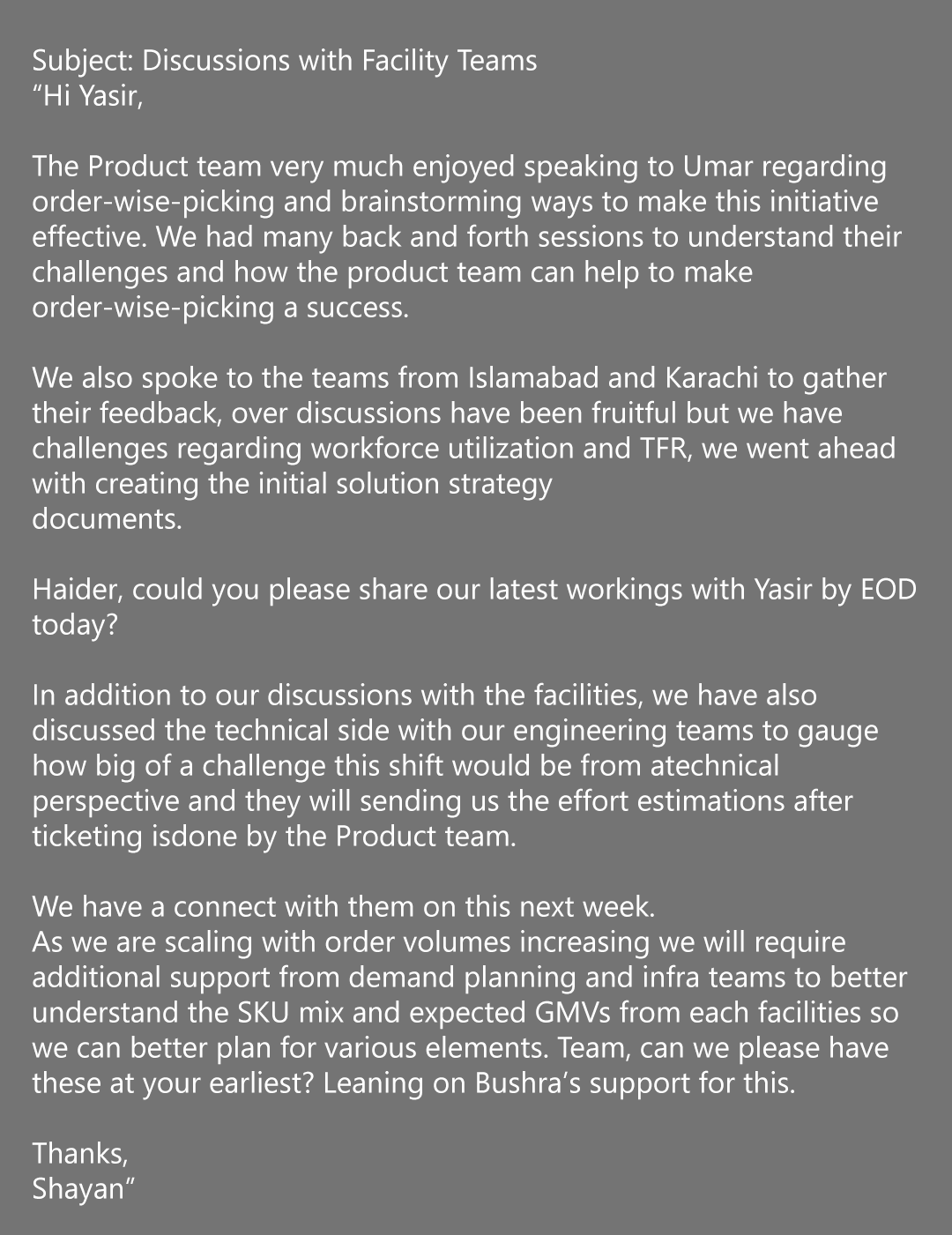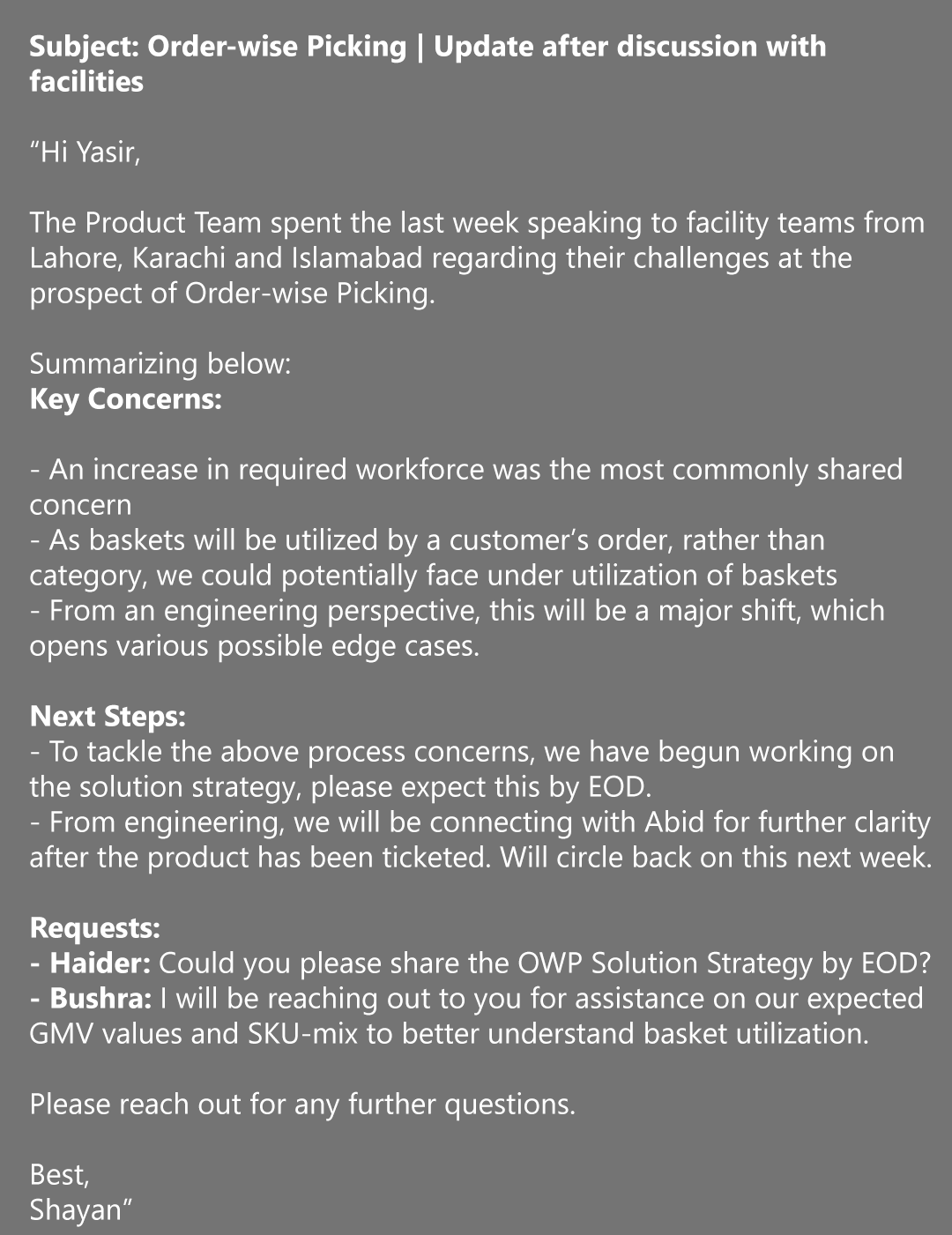In a perfect world, a member of the product team encounters an exciting opportunity where a technology solution could add significant business value. This opportunity could be a growth bet or a business problem solving which would unlock tremendous value. You write up a Product Requirements Document (PRD), which will be the conception of the high-potential technology solution.
For a Product Manager, the quality of documentation will be the biggest determinant of success in shipping high-quality, high-impact products at high-velocity.
In our perfect world, the Product Manager creates this document which sparks a series of events with different stakeholders reading the same document and autonomously acting accordingly. The end-result being that without much involvement/hand-holding on your part, having just written a PRD, you’re able to leverage the entire organization to unlock tremendous value. Your proverbial pen (read: keyboard) being mightier than the sword.
While I’ve enjoyed tooting my own horn, I have to say that the importance of crisp documentation is not just leveraged by or limited to the Product Team. In an organisation much like ours, documentation takes various shapes and forms; and perhaps the one form used by every individual is email.
Let’s take a few examples where initiatives would be communicated via email: our Supply Ops team would come forward to discuss the challenges of order-wise picking, or our Category team would propose a promotion scheme on certain SKUs to encourage sales. In both scenarios, the teams are communicating their expertise, insights and recommendations. This communication requires buy-in from relevant stakeholders so it can ultimately be strategized and translated into something actionable.
In an un-ideal world, if our documentation is not effective, stakeholders would not be able to get clarity on what exactly is required for them to do and you will have to spend numerous hours/days explaining things over calls/meetings – individually to each stakeholder group. Or, in the most unfavourable outcome, your initiative could be overlooked while it could have been the key to unlocking that business value or (for my product people) reaching the promised land of ‘product-market-fit’. Since we all are (hopefully) striving to be like an ideal communicator, here are some learnings on how to write effective documentation.
1. Do you thin-slice?
A concept discussed in Malcolm Gladwell’s book ‘Blink: The Power of Thinking Without Thinking’, talks about ‘thin-slicing’. Within the opening paragraph of your document, your reader subconsciously decides how much brain power they are willing to invest. It is within this opening, that you must communicate the important context to your reader. This is where you intentionally ‘thinly-slice’ the overall message of your document into the opening paragraph.
2. Do you follow top-down communication?
Top-down communication is a method more typically used and taught in consulting firms. This method structures information where the most critical elements or conclusions are stated in the beginning, with details being shared as the reader goes on.
Picture a pyramid in your head. This pyramid, that you have imagined, is the visual represenation of your email or document and this is how your reader also views it. Here you must assist your reader by structuring and fitting your message according to this pyramid. In this pyramid, your core message remains at the top, with the underlying arguments and deliberations acting as support at the bottom.
3. Do you keep it MECE? (said: me-see)
MECE stands for mutually exclusive, collectively exhaustive. One of the biggest challenges we have when it comes to documenting and communicating information is dealing with many points to convey or even large data sets that need to be explained. MECE is a concept that helps you make sure you’re not repeating what you’re saying. To make sure you’re not repeating what you’re saying, you can use the MECE concept. (sorry)
Let’s break MECE down: the first part being, Mutually Exclusive. Within your document, try to make sure the separate points you wish to convey, each hold their own unique and actionable piece of insight or information. If within your email or documentation you have multiple points to write down, lead with the core message these points are conveying and group them together in a single bullet or paragraph and try not to repeat the same message again.
The second part of MECE is, Collectively Exhaustive. As you group your points to be Mutually Exclusive, you should also make sure that all your points, when read together, cover the entirety of your core message. Here, you are further assisting the reader to grasp all the information that you are communicating and all the information is grouped by their unique actionable insights.
4. Do you like takeaways?
Takeaways are a wonderful thing. The kind that you write in your emails, and the kind you get from restaurants – for now, we’ll talk about the former. When done right, the takeaway is arguably the most important and effective aspect
of your email or document. The takeaway is where your stakeholder or reader comes to understand what the next action items are. This could be for your manager when you request for support or for your team when you delegate critical tasks. A good takeaway has basic components:
a. Effectively summarize the context, where appropriate
When you’re writing an email to a busy person, who may not have the time to go through the entire message, the takeaway summary would be the ideal location for them to grab a quick view of the project plan, the initiative or the
request. Again, this is ideal where appropriate, not every piece of communication needs a context summary.
b. Leave important actions in the takeaway
Whenever you need to address someone for an important action, it is always best to leave this in the takeaway section, as opposed to addressing them somewhere in the middle of the email or document. Here, you are making it easier for your reader to catch this task and easily understand their deliverable in a single bullet point.
c. Communicate your expectations
It is always best to leave your expectations at the end of the message. This could be communicating the deadline for a project or an ideal outcome. When the expectation is the last thing your audience reads, it brings them into an action-focused mindset where their end-goal has been clearly defined and sets them up to immediately act upon achieving your unified goal.
5. Do you format?
Probably the lowest-hanging-fruit in this article, and perhaps the one thing I wish you would take from this would be to understand the value of formatting. Archimedes said, “Give me a lever and a place to stand, and I will move the Earth.” – effectively formatting a document is your metaphoric lever to moving the earth. As you use the above points in structuring your document, try to format it with appropriate use of font, headings, sub-headings, bullets, and bolded words. These elements, seemingly menial, hold the highest points of leverage in emphasizing takeaways, structuring context, and even directing your readers’ vision.
If you’ve made it this far, allow me to create a takeaway element for you where I try to put into practice the suggestions above. Starting with a not-so-ideal form of communication to Yasir, updating him on the Product Team’s workings regarding order-wise picking:
Let’s try that again?
Crisp documentation is a skill I try to inculcate in my own my team. Product Management is a highly leveraged field with the potential for some Product Managers to be 10x as effective in driving solutions, as compared to an average Product Manager purely due to the two scenarios illustrated above, where the single differentiator being the quality of the PRDs (or documentation). Add to that the time saved for all the other stakeholders for not being required to be engaged back-and-forth for two weeks over a single feature, and an ideal Product Manager can be 50x more effective as compared to a not-so-ideal Product Manager.
If, you are able to put the above into practice, not only could you possibly achieve more success in your communication but perhaps enrich your professional and private life as well.
_________________________________________________________________________
The contents of this article have been inspired by learnings from various individuals and books, and significantly the guidance of an old mentor, Mr. Ali Mehdi Rizvi.
About the Writer
Mirza Shayan Baig is a Senior Product Manager at Jugnu. His spirit animal is a cat, and white is his favorite color.

